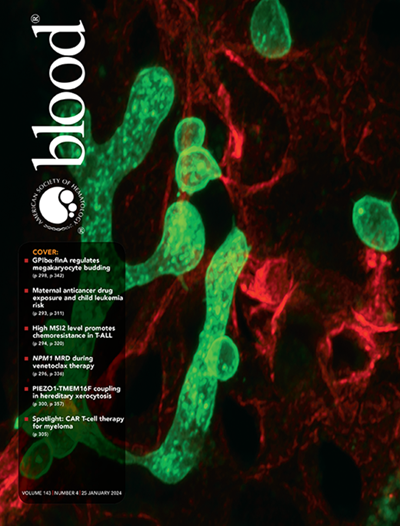融合基因缺失消除干性并诱导急性髓系白血病双向分化。
IF 23.1
1区 医学
Q1 HEMATOLOGY
引用次数: 0
摘要
产生新的融合基因的染色体重排是急性髓性白血病(AML)的一个标志。细胞系模型中的耗尽实验表明,它们的持续表达是维持其白血病表型所必需的,因此融合基因代表了理想的癌症特异性治疗靶点。然而,这一结果在多大程度上适用于原代细胞造血发育的不同阶段,以及治疗剂是否能有效地递送到这些细胞中,目前尚不清楚。在这项研究中,我们证明了携带染色体易位t(8;21)的原发AML细胞严重依赖于相应的融合基因RUNX1::RUNX1T1来抑制分化和维持干细胞性。使用装载sirna的脂质纳米颗粒沉默RUNX1::RUNX1T1的表达可诱导染色质可及性的实质性变化,从而将白血病相关的转录网络重定向到髓细胞分化程序。单细胞分析显示,这种转录重编程与未成熟干细胞和祖细胞样细胞群的消耗有关,伴随着粒细胞和嗜酸性细胞/肥大细胞样细胞群的扩张,这些细胞群的自我更新能力受损。这些发现强调了RUNX1::RUNX1T1在维持AML中的重要作用,并强调了靶向融合基因表达在原发性AML细胞中的治疗潜力。本文章由计算机程序翻译,如有差异,请以英文原文为准。
Fusion Gene Depletion Eliminates Stemness and Induces Bidirectional Differentiation of Acute Myeloid Leukemia.
Chromosomal rearrangements that generate novel fusion genes are a hallmark of acute myeloid leukemia (AML). Depletion experiments in cell line models have suggested that their continued expression is required for maintaining their leukemic phenotype and that fusion genes therefore represent ideal cancer-specific therapeutic targets. However, to which extent this result holds true for the different stages of hematopoietic development in primary cells and whether therapeutic agents can be efficiently delivered to those cells is still unclear. In this study, we demonstrate that primary AML cells harboring the chromosomal translocation t(8;21) are critically dependent on the corresponding fusion gene, RUNX1::RUNX1T1, to suppress differentiation and maintain stemness. Silencing RUNX1::RUNX1T1 expression using siRNA-loaded lipid nanoparticles induces substantial changes in chromatin accessibility, thereby redirecting the leukemia-associated transcriptional network towards a myeloid differentiation program. Single-cell analyses reveal that this transcriptional reprogramming is associated with the depletion of immature stem and progenitor-like cell populations, accompanied by an expansion of granulocytic and eosinophilic/mast cell-like populations with impaired self-renewal capacity. These findings underscore the essential role of RUNX1::RUNX1T1 in sustaining AML and highlight the therapeutic potential of targeting fusion gene expression in primary AML cells.
求助全文
通过发布文献求助,成功后即可免费获取论文全文。
去求助
来源期刊

Blood
医学-血液学
CiteScore
23.60
自引率
3.90%
发文量
955
审稿时长
1 months
期刊介绍:
Blood, the official journal of the American Society of Hematology, published online and in print, provides an international forum for the publication of original articles describing basic laboratory, translational, and clinical investigations in hematology. Primary research articles will be published under the following scientific categories: Clinical Trials and Observations; Gene Therapy; Hematopoiesis and Stem Cells; Immunobiology and Immunotherapy scope; Myeloid Neoplasia; Lymphoid Neoplasia; Phagocytes, Granulocytes and Myelopoiesis; Platelets and Thrombopoiesis; Red Cells, Iron and Erythropoiesis; Thrombosis and Hemostasis; Transfusion Medicine; Transplantation; and Vascular Biology. Papers can be listed under more than one category as appropriate.
 求助内容:
求助内容: 应助结果提醒方式:
应助结果提醒方式:


